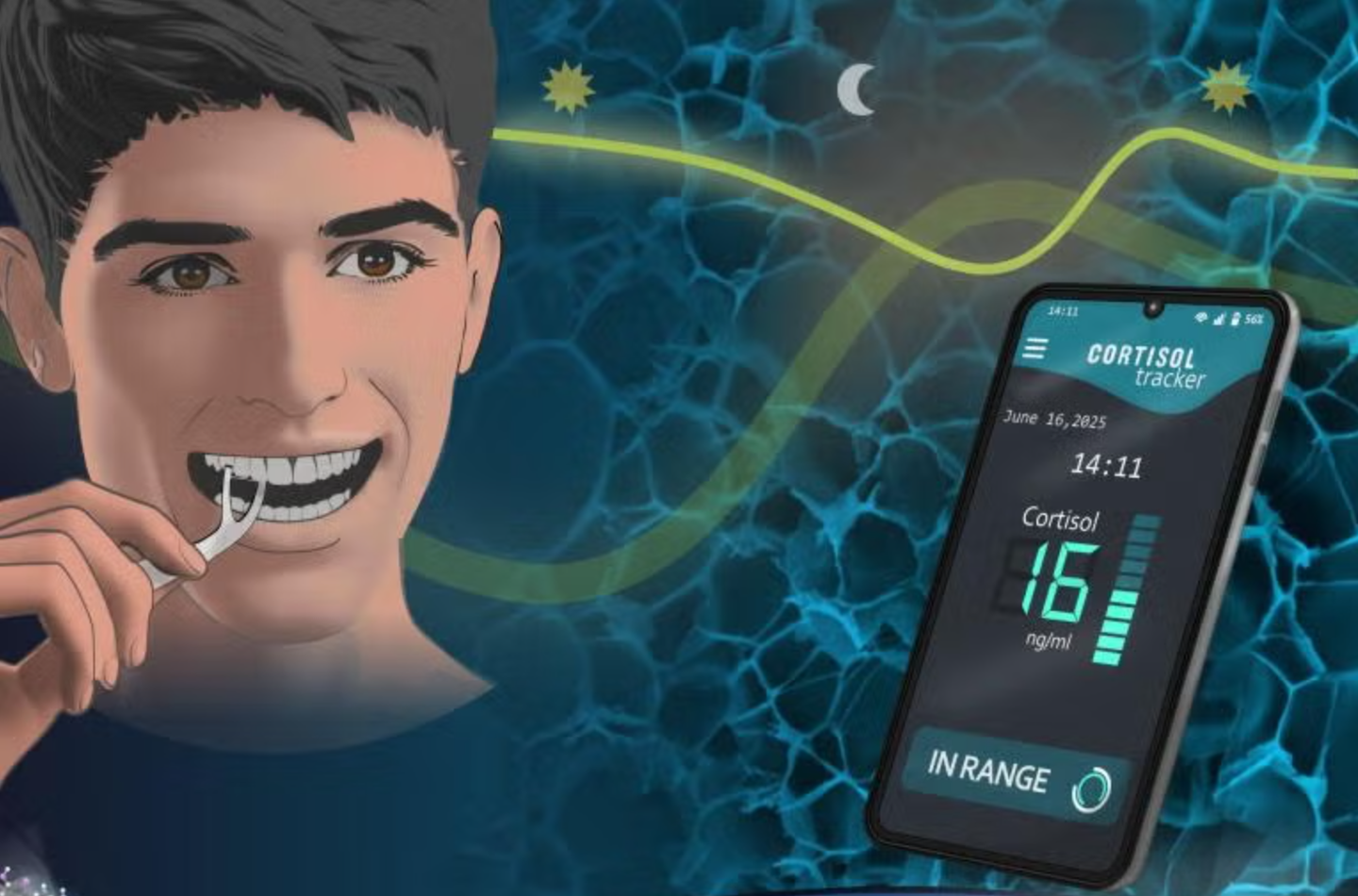Revolutionary smart dental floss tracks your stress in real time
A new floss device can measure stress hormone levels in real time using saliva, offering a simple and accurate tool for health tracking.

New floss device measures cortisol in saliva to track stress in real time—no lab or needles needed. (CREDIT: Nafize Ishtiaque Hossain)
A new device could soon change how people track their stress—and all it takes is flossing your teeth.
Developed by researchers at Tufts University, this innovative dental floss does more than clean your mouth. It collects your saliva and measures cortisol, a hormone linked to stress, in real time. The system blends a thread-based microfluidic sensor with cutting-edge materials that can detect minute levels of cortisol quickly and accurately.
A New Way to Track Stress
Stress is a natural response to life’s challenges. Short-term stress can help you stay focused. But long-term stress is linked to health problems like high blood pressure, anxiety, depression, and heart disease. Detecting and managing chronic stress is vital to staying healthy.
Yet, the tools we use to measure stress haven’t kept up. Right now, people often rely on questionnaires or psychiatric evaluations, which are subjective and don’t give instant feedback. Blood tests can track stress hormones, but they’re not convenient for daily use. They need lab visits and equipment most people don’t have access to.
That’s why a team led by Sameer Sonkusale, a professor of electrical and computer engineering at Tufts, wanted a stress monitor that fit seamlessly into everyday life.
“It started in a collaboration with several departments across Tufts, examining how stress and other cognitive states affect problem solving and learning,” said Sonkusale. “We didn’t want measurement to create an additional source of stress, so we thought, can we make a sensing device that becomes part of your day-to-day routine? Cortisol is a stress marker found in saliva, so flossing seemed like a natural fit to take a daily sample.”
Related Stories
Turning Dental Floss into a Lab
The flossing device looks like a typical plastic floss pick. But when you floss, the thread captures saliva and sends it through a narrow channel to a flexible sensor hidden in the handle. This microfluidic thread uses capillary action to move saliva to a detection area. There, embedded electrodes analyze cortisol levels on the spot.
The secret lies in how the sensor detects cortisol. The team used a method called electropolymerized molecularly imprinted polymers—or eMIPs. These are synthetic materials that can “remember” and capture specific molecules.
Think of it like making a mold of a key. A polymer is formed around a cortisol molecule, then the molecule is removed, leaving behind a perfect mold. When new cortisol molecules enter, they fit into the mold and trigger a response in the sensor.
This internal detection system doesn’t need extra chemicals or sample prep, unlike older tests. It’s faster, cleaner, and easier to use.
The sensor can spot cortisol levels as low as 0.048 picograms per milliliter. That’s nearly 100,000 times lower than the typical cortisol level in saliva during stress. And it only takes about 12 minutes to get a result.
Proven Accuracy, Real-World Promise
Tests using both artificial and human saliva showed the floss sensor’s accuracy nearly matches that of standard lab tests like ELISA. Results had a 98.64–102.4% recovery rate with only 5% variation. The readings also matched closely with traditional methods, showing a correlation of 0.9910—a near-perfect match.
The platform’s sensor is made using a special laser-engraved graphene material, which offers high surface area and excellent electrical properties. This boosts sensitivity and ensures precise detection, even in complex saliva samples.
The floss contains four working parts: the saliva collection thread, a capillary microfluidic channel, a flexible electrochemical sensor, and a waste zone. The sensor uses a polypyrrole-prussian blue matrix that generates an electrical signal when cortisol binds to its memory sites. This signal is sent wirelessly to a mobile device for easy tracking.
Unlike bulkier stress sensors like mouthguards, this floss-based version doesn’t feel intrusive. Because it’s used as part of a normal hygiene routine, it encourages consistent use without raising anxiety or requiring extra effort. That’s important because even the act of measuring stress can trigger stress, skewing the results.
Beyond Stress: A Platform for Other Conditions
The dental floss sensor doesn’t just stop at cortisol. Because eMIP technology is versatile, researchers can quickly design sensors for other salivary biomarkers. That includes estrogen for fertility tracking, glucose for diabetes, or markers for early cancer detection. There’s even potential to track multiple biomarkers at once for a fuller picture of your health.
“The eMIP approach is a game changer,” said Sonkusale. “Biosensors have typically been developed using antibodies or other receptors that pick up the molecule of interest. Once a marker is found, a lot of work has to go into bioengineering the receiving molecule attached to the sensor. eMIP does not rely on a lot of investment in making antibodies or receptors. If you discover a new marker for stress or any other disease or condition, you can just create a polymer cast in a very short period of time.”
Sonkusale believes the biggest value of this new floss isn’t in diagnosis, but in regular monitoring. For now, blood is still the gold standard for diagnosing medical conditions. But saliva testing is a great way to keep tabs on how treatments are working, or to flag early signs of trouble.
“For diagnostics, blood is still the gold standard,” he explained, “but once you are diagnosed and put on medication, if you need to track, say, a cardiovascular condition over time to see if your heart health is improving, then monitoring with the sensor can be easy and allows for timely interventions when needed.”
Toward Smarter, Easier Healthcare
The research was published in ACS Applied Materials and Interfaces and adds to a growing body of work by Sonkusale’s group. His lab has created sensors that can be woven into clothing to track body motion, detect gases, or monitor sweat.
Now, the team is preparing to launch a startup to bring the smart floss sensor to market. If successful, the device could change how people monitor not just stress, but many health conditions—without blood draws, bulky gear, or complicated tests.
As interest in point-of-care testing grows, this device offers a glimpse into the future of noninvasive, real-time health monitoring. One where a simple daily habit could double as a powerful medical tool.
Note: The article above provided above by The Brighter Side of News.
Like these kind of feel good stories? Get The Brighter Side of News' newsletter.



